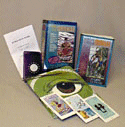
Rooted in the African Yoruban beliefs, "Tarot of the Orishas" is a far cry from the traditional Tarot deck. The Orishas (also called Orixa) translate to supernatural or superhuman beings. "The Orixa is pure energy," explains the LWB (little white booklet), "energy detached from an even greater energy which created all things; the Orixa is God's energy or His creation on Earth." As the African slaves adapted their beliefs to those of their masters, they developed correspondences (listed in a table) between the Orishas and the Catholic saints. The religious nature of the deck is best reflected in the "Recommendations for Use", which have the feel of holy commandments.
While the deck has 77 cards, it's not exactly missing one. The "majors" are 25 unnumbered Orishas of the Yoruban pantheon. A table relating the Orisha cards to traditional major arcana includes five Orishas without a match, and omits any equivalents for Strength and the Hierophant. The secondary (minor) cards are four element-based suits of thirteen each, numbered one through ten, followed by the Message of the Element (an advice card), the Element itself (their abstract qualities), and an Elemental "linking them with professions and personalities."
The multi-lingual nature of the Yoruba is reflected in the box, printed in both English and Spanish, and the separate English and Spanish LWBs. The cards are labelled in both languages, and in Portugese as well. The suit cards have astrological symbols at the bottom, although no reference is made to them in the LWB. Both upright and reversed meanings are listed for each card, with the reverse sometimes referred to as "badly affected by other cards". Unfortunately, the English LWB isn't consistent in using the Orishas' English names, making it difficult to find a particular card's description.
More detailed than most LWBs, it goes on to feature both traditional and new spreads. This Astrological Houses spread has a twist, in that the wheel is done once around with Orisha cards, then twice with the suit cards, reading all three together in each position. The Paxoro layout uses 25 cards in layers placed right to left, beginning with nine on the bottom row and narrowing to a single card at the top. The Ansata Cross is an ankh-shaped variation of the Celtic (also included). A Gizeh Pyramids layout uses three smaller pyramids of six cards each, representing Cheops, Chephren, and Mycerinus, to present a complex variant of a past / present / future spread. Perhaps the most unusual is the Seventh Chakra spread, which lays out fifteen cards in a circle surrounding three in the middle. Only five of the circle cards are acutally used, however; the rest are just place holders.
The cardstock used in this deck is very thin and flexible. The backs feature a plain silver circle in the center, surrounded by fourteen gold stars on a solid dark purple background. The shade of purple varies from card to card in my deck, probably due to printing variations from sheet to sheet. Durkon's illustrations use bright, vibrant colors, but the style is inconsistent. Some of the people are Caucasian looking, the (better drawn) majority are dark-skinned. The suit cards are full scenes rather than pips, featuring birds for the suit of Air, mammals for Earth, and sea life for Water. Fire, on the other hand, runs the gamut from volcanoes (Nine) to men fighting dragons (Five and Seven), with a lion on the Ace. Some of the Orishas are wonderful portraits - especially nice are Shango (Justice) and Oshun (Priestess) - while others look like half-finished sketches. The artwork overall is okay, but nothing struck me as spectacular.
The main drawback this deck holds for me is that the symbolism is consistently very hard to grasp. I found few visual cues to help remember the meanings. The upright meaning listed for the III of Earth, for example, is "Work, service and savings are put together with great effort. Talent and wisdom. It might concern perfect associations." The picture shows a family of giraffes grazing, which (to me) has nothing to do with either work or effort.
"Tarot of the Orishas" is definitely not a deck for beginners. It might be more appropriate for the experienced reader wanting to expand to similar divination methods. I have not seen the companion (bilingual) book for this deck, perhaps it explains things more clearly than the LWB can. I certainly hope so. The book and deck are available separately, but I would recommend getting them together as a kit.